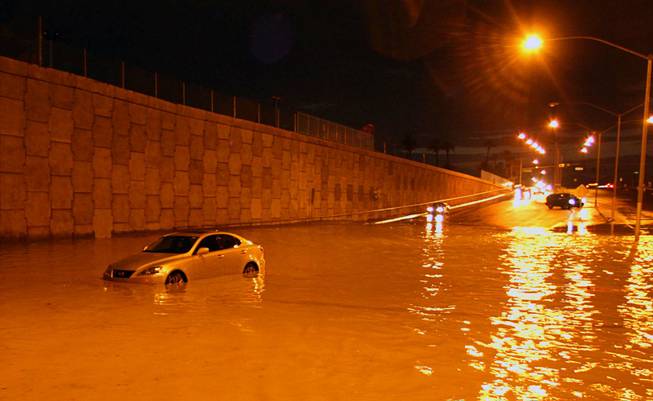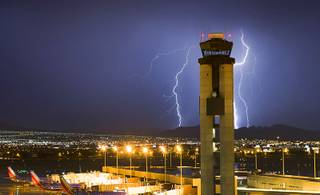
Richard Brian
A car is abandoned in storm run-off on Twain Avenue, west of Dean Martin Drive, after a thunderstorm dumped rain cross the Las Vegas Valley Friday, July 19, 2013.
Tuesday, July 23, 2013 | 2 a.m.
Valley residents and visitors may have found their phones buzzing and chiming unexpectedly during this weekend’s storms as a series of flash flood warnings were broadcast over a system introduced last year by the federal government.
The Wireless Emergency Alerts system was launched in April 2012 and provides short warning messages to enabled cellular phones and mobile devices.
The system, which is run by the Federal Emergency Management Agency, broadcasts three types of messages — alerts from the president, Amber Alerts and alerts of imminent threats to safety or life.
Weather alerts fall under the third category and the broadcasts are automatically sent out anytime the National Weather Service issues a warning, said Dan Berc, a Las Vegas-based warning coordination meteorologist with the NWS.
“It’s a quick notification system that your location is affected by high-impact weather like a flash flood,” he said.
Eight different types of weather events, ranging from tornadoes to tsunamis, can trigger the warnings, but in Clark County the alerts usually are limited to flash floods and dust storms, Berc said.
Every time a flood warning is issued or modified, the system sends out an alert, which can lead to residents receiving several notifications over the course of a storm.
The alerts are accompanied by an attention signal and vibration that go off even if a cellphone is on silent mode — and they were heard during several Las Vegas Strip shows during Friday and Saturday night’s storms.
The messages are generally limited to 90 characters of text and don’t cost anything to receive.
The cellphone-based alert system is targeted geographically, so only those in the area of the warning will be notified.
“Any cellphone towers within a flash flood warning polygon will be alerted,” Berc said, “and anyone within reach of those towers will get the warning.”
The system is more efficient than similar warnings broadcast over the radio, Berc said, because radio warnings can’t be targeted and are broadcast throughout the entire county, even if a storm is 80 miles away from the valley in Mesquite.
Not all phones are equipped to receive the wireless emergency alerts, but most phones, especially smartphones, released within the past two years have the technology already enabled at the time of purchase. Popular phones that support the service include the three most recent iPhone versions, several Blackberry manufactured phones, Samsung’s line of Galaxy phones, plus models from HTC, Motorola and LG.
Phones that don’t have the service pre-equipped can sign up for warnings by downloading one of a variety of apps like The Weather Channel app or ping4alerts.
All of the major cellphone carriers, including, AT&T, Verizon Wireless, Sprint Nextel and T-Mobile, support the service.
Users can opt out of the weather alerts and Amber alerts, but not presidential alerts. Opting out can often be done in the phone’s system settings, although the process may vary by device.


Join the Discussion:
Check this out for a full explanation of our conversion to the LiveFyre commenting system and instructions on how to sign up for an account.
Full comments policy